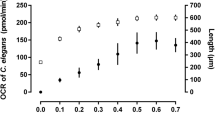Abstract
The contamination of heavy metals, a class of naturally occurring and persistent toxicants, has become a major public health concern due to increasing industrial and anthropogenic activities. The use of COPAS Biosort, a flow cytometer capable of measuring thousands of nematodes in minutes via high-throughput assays, has been widely applied in C. elegans studies for assessing toxicity of individual metals; however, such application yet to be seen for metals or other chemical mixtures. In the present protocol, we investigated toxic effects of individual metals, Cd, Pb, and Mn, as well as their binary and ternary mixtures, using nematode C. elegans. The toxic outcomes, including effects on growth, reproduction, and feeding behavior, were measured using high-throughput platform analysis (COAPS Biosort).
Access this chapter
Tax calculation will be finalised at checkout
Purchases are for personal use only
Similar content being viewed by others
References
Byber K, Lison D, Verougstraete V, Dressel H, Hotz P (2016) Cadmium or cadmium compounds and chronic kidney disease in workers and the general population: a systematic review. Crit Rev Toxicol 46(3):191–240. https://doi.org/10.3109/10408444.2015.1076375
Cinnirella S, Hedgecock IM, Sprovieri F (2014) Heavy metals in the environment: sources, interactions and human health. Environ Sci Pollut Res Int 21(6):3997–3998. https://doi.org/10.1007/s11356-013-2486-z
Jomova K, Valko M (2011) Advances in metal-induced oxidative stress and human disease. Toxicology 283(2–3):65–87. https://doi.org/10.1016/j.tox.2011.03.001
Lim JT, Tan YQ, Valeri L, Lee J, Geok PP, Chia SE, Ong CN, Seow WJ (2019) Association between serum heavy metals and prostate cancer risk—a multiple metal analysis. Environ Int 132:105109. https://doi.org/10.1016/j.envint.2019.105109
Rehman K, Fatima F, Waheed I, Akash MSH (2018) Prevalence of exposure of heavy metals and their impact on health consequences. J Cell Biochem 119(1):157–184. https://doi.org/10.1002/jcb.26234
Caito S, Aschner M (2015) Neurotoxicity of metals. Handb Clin Neurol 131:169–189. https://doi.org/10.1016/b978-0-444-62627-1.00011-1
Balistrieri LS, Mebane CA (2014) Predicting the toxicity of metal mixtures. Sci Total Environ 466–467:788–799. https://doi.org/10.1016/j.scitotenv.2013.07.034
Adebambo OA, Ray PD, Shea D, Fry RC (2015) Toxicological responses of environmental mixtures: environmental metal mixtures display synergistic induction of metal-responsive and oxidative stress genes in placental cells. Toxicol Appl Pharmacol 289(3):534–541. https://doi.org/10.1016/j.taap.2015.10.005
Cobbina SJ, Chen Y, Zhou Z, Wu X, Feng W, Wang W, Mao G, Xu H, Zhang Z, Wu X, Yang L (2015) Low concentration toxic metal mixture interactions: effects on essential and non-essential metals in brain, liver, and kidneys of mice on sub-chronic exposure. Chemosphere 132:79–86. https://doi.org/10.1016/j.chemosphere.2015.03.013
Leung MC, Williams PL, Benedetto A, Au C, Helmcke KJ, Aschner M, Meyer JN (2008) Caenorhabditis elegans: an emerging model in biomedical and environmental toxicology. Toxicol Sci 106(1):5–28. https://doi.org/10.1093/toxsci/kfn121
Meyer D, Williams PL (2014) Toxicity testing of neurotoxic pesticides in Caenorhabditis elegans. J Toxicol Environ Health B Crit Rev 17(5):284–306. https://doi.org/10.1080/10937404.2014.933722
Hunt PR (2017) The C. elegans model in toxicity testing. J Appl Toxicol 37(1):50–59. https://doi.org/10.1002/jat.3357
Queiros L, Pereira JL, Goncalves FJM, Pacheco M, Aschner M, Pereira P (2019) Caenorhabditis elegans as a tool for environmental risk assessment: emerging and promising applications for a “nobelized worm”. Crit Rev Toxicol 49(5):411–429. https://doi.org/10.1080/10408444.2019.1626801
Pulak R (2006) Techniques for analysis, sorting, and dispensing of C. elegans on the COPAS flow-sorting system. Methods Mol Biol 351:275–286. https://doi.org/10.1385/1-59745-151-7:275
Boyd WA, Smith MV, Kissling GE, Freedman JH (2010) Medium- and high-throughput screening of neurotoxicants using C. elegans. Neurotoxicol Teratol 32(1):68–73. https://doi.org/10.1016/j.ntt.2008.12.004
Boyd WA, McBride SJ, Rice JR, Snyder DW, Freedman JH (2010) A high-throughput method for assessing chemical toxicity using a Caenorhabditis elegans reproduction assay. Toxicol Appl Pharmacol 245(2):153–159. https://doi.org/10.1016/j.taap.2010.02.014
Boyd WA, Smith MV, Freedman JH (2012) Caenorhabditis elegans as a model in developmental toxicology. Methods Mol Biol 889:15–24. https://doi.org/10.1007/978-1-61779-867-2_3
Chou TC (2006) Theoretical basis, experimental design, and computerized simulation of synergism and antagonism in drug combination studies. Pharmacol Rev 58(3):621–681. https://doi.org/10.1124/pr.58.3.10
Wang Y, Chen C, Qian Y, Zhao X, Wang Q, Kong X (2015) Toxicity of mixtures of lambda-cyhalothrin, imidacloprid and cadmium on the earthworm Eisenia fetida by combination index (CI)-isobologram method. Ecotoxicol Environ Saf 111:242–247. https://doi.org/10.1016/j.ecoenv.2014.10.015
Rodea-Palomares I, Petre AL, Boltes K, Leganes F, Perdigon-Melon JA, Rosal R, Fernandez-Pinas F (2010) Application of the combination index (CI)-isobologram equation to study the toxicological interactions of lipid regulators in two aquatic bioluminescent organisms. Water Res 44(2):427–438. https://doi.org/10.1016/j.watres.2009.07.026
Williams PL, Dusenbery DB (1990) Aquatic toxicity testing using the nematode, Caenorhabditis elegans. Environ Toxicol Chem 9(10):1285–1290
Brenner S (1974) The genetics of Caenorhabditis elegans. Genetics 77(1):71–94
Chou TC, Talalay P (1984) Quantitative analysis of dose-effect relationships: the combined effects of multiple drugs or enzyme inhibitors. Adv Enzym Regul 22:27–55
Boyd WA, Smith MV, Kissling GE, Rice JR, Snyder DW, Portier CJ, Freedman JH (2009) Application of a mathematical model to describe the effects of chlorpyrifos on Caenorhabditis elegans development. PLoS One 4(9):e7024
Author information
Authors and Affiliations
Corresponding author
Editor information
Editors and Affiliations
Rights and permissions
Copyright information
© 2021 Springer Science+Business Media, LLC, part of Springer Nature
About this protocol
Cite this protocol
Xue, K.S., Tang, L. (2021). High-Throughput Measurement for Toxic Effects of Metal Mixtures in Caenorhabditis elegans. In: Pan, X., Zhang, B. (eds) Environmental Toxicology and Toxicogenomics. Methods in Molecular Biology, vol 2326. Humana, New York, NY. https://doi.org/10.1007/978-1-0716-1514-0_2
Download citation
DOI: https://doi.org/10.1007/978-1-0716-1514-0_2
Published:
Publisher Name: Humana, New York, NY
Print ISBN: 978-1-0716-1513-3
Online ISBN: 978-1-0716-1514-0
eBook Packages: Springer Protocols




